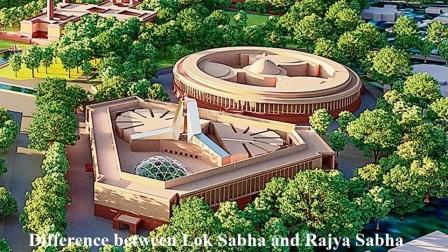Parliament has its own unique place in a democratic country. Being a democratic country, Lok Sabha and Rajya Sabha have important place and role in India.
In this article we will try to know what is the “difference between Lok Sabha and Rajya Sabha”.
India has two legislative houses – the Lok Sabha and the Rajya Sabha. The Lok Sabha members are directly elected to the house by the people of India whereas the Rajya Sabha members are elected by the members of the state legislatures. This is a ‘two house” or “bicameral’ system of legislature.
Why are two houses needed? If there was only a Lok Sabha, how would things change? Well India is a union in which power is divided between the centre and the states.
The parliament is the supreme law-making body of the country so it has to work with the state legislatures to perform its functions. This interactive cooperation is ensured by the Rajya Sabha whose members are elected by the state legislatures.
There are many advantages of having two houses in parliament. For one, the parliament needs experts, especially subject experts and professionals who are accomplished in their fields (like scientists, legal experts, industrialists, writers, artists etc) if it has to perform its functions properly.
It is not always possible for such experts to win an election to enter parliament. The state legislatures can choose such In this article we will try to know what is the difference between Lok Sabha and Rajya Sabha.
the Parliament (President, Rajya Sabha, Lok Sabha) is the supreme body of law making.
In the Parliament, Rajya Sabha is considered as the upper house and Lok Sabha is considered as the lower house.
Apart from the similarities in both the houses, there are also dissimilarities which are as follows.
Difference between Rajya sabha and Lok sabha
| S.N. | Rajya sabha | Lok Sabha |
|
1 |
Rajya Sabha is a permanent house which
can never be dissolved by anyone, one-third of the members retire after every two years and the same number are newly elected. |
The Lok Sabha is not a permanent house,
its tenure is five years and even before that it can be dissolved by the President on the advice of the Prime Minister. The election of the new Lok Sabha should be held within six months. |
|
2 |
The number of members of the Rajya Sabha is 250.
In this all states are not given equal representation. Members are elected on the basis of population. In this, 12 members are nominated by the President for making special contributions in any field. |
Lok sabha can have a maximum of 552
members, out of which 530 are from the states, 20 from the union territories and 2 Anglo-Indian members are nominated by the President. |
|
3 |
Election of the members of the Rajya Sabha is
done by the Legislative Assemblies of the respective states on the basis of proportional representation. |
Members of the Lok Sabha are elected
by the public by public and secret ballot, they are elected on the basis of population. |
|
4 |
The Chairman of Rajya Sabha is not its
member. The Vice President of India is the ex- officio Chairman of the Rajya Sabha. Its Deputy Chairman is its member and only the members of Rajya Sabha elect it. |
The Speaker and the Deputy Speaker
of the Lok Sabha are its members and they are elected by the members of the House. |
|
5 |
Money Bill cannot be introduced or restored in Rajya Sabha. | Money Bill can be restored only in the Lok Sabha. |
|
6 |
The Rajya Sabha has only the right to make
recommendations in relation to the Money Bill. 14 days time is given, if the bill is not returned in this time, then it is considered passed. |
The Lok Sabha is not bound to accept
the recommendations of the Rajya Sabha. The Lok Sabha has the final and real authority in relation to money bills. |
|
7 |
The Council of Ministers is not responsible to the Rajya Sabha. | The Council of Ministers is responsible only to the Lok Sabha. |
|
8 |
The Rajya Sabha has the right to declare any subject
of the State List to be of national importance by a resolution supported by at least two-thirds of the members present and voting in the Rajya Sabha. |
The Lok Sabha does not have the right
to declare the subject of the State List as of national importance. |
|
9 |
All India Services to the Rajya Sabha by a two- thirds majority of the members present
and voting in the Rajya Sabha. has the right to create. |
Lok Sabha does not have the right to create All India Services. |
|
10 |
When the Lok Sabha is dissolved and emergency is imposed, it is approved by the Rajya Sabha. | The Lok Sabha does not need such a special power because the Rajya Sabha does not dissolve. |
|
11 |
For the removal of the Vice-President, a motion is initiated in the Rajya Sabha itself. | Approves the resolution passed by the Rajya Sabha. |
|
12 |
Three sessions : Winter, Monsoon, and Budget ( The budget session is in two parts | Three sessions : Winter, Monsoon, and Budget |
|
13 |
Age of the members must be over 30 years | At least 25 year old |
|
14 |
Qurom ( minimum presence to make the proceeding valid 1/10 of total membership | 1/10 of total membership |


Howdy! This post could not be written any better! Going through this article reminds me of my
previous roommate! He continually kept talking about this.
I’ll send this post to him. Fairly certain he’s going to have a good read.
Thank you for sharing!
International news, politics, business, technology, climate change, health and wellness, sports, science, weather, lifestyle and more
https://www.washingtontimesnewstoday.com/
Latest news on politics, business, lifestyle, sports and more from Turkey and the world at turkeynewstoday.com
https://www.turkeynewstoday.com/
https://www.ibm.com
Forbes News Today is a global media company, focusing on business, investing, technology, entrepreneurship, leadership, and lifestyle
https://www.forbesnewstoday.com/
Latest US news, world news, sports, business, opinion, analysis and reviews from the Guardian, the world’s leading liberal voice.
https://www.guardiannewstoday.com